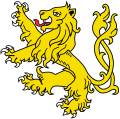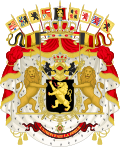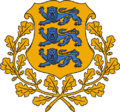Lions in heraldry
Lions appear in heraldry more often than any other animal. It traditionally symbolises bravery, valour, strength, and royalty.
They may appear as a charge on the shield or as a crest. They are described in the blazon (heraldic description) by their tincture (color) and attitude (position). Sometimes the teeth and claws of a lion can be colored differently from the rest of its body; it is said to be "armed" of that color (e.g. "A lion Or armed gules" is a gold lion with red teeth and claws). Sometimes the tail is even described, if it is shown in an unusual way. One reason why lions are shown in so many different ways is because when heraldry developed, a lot of people wanted a lion on their coat of arms, but no two coats of arms can be the same. The purpose of heraldry in the Middle Ages was to identify people with bold images over the outside of their armour. Since a lot of people started putting lions on their coats of arms, they placed them in a lot of different positions and in every color used in heraldry. In France and Germany, they even made patterns of colors on some of their lions, as if they were painted.
French heralds refer to lions in the walking positions as leopards, but this term is seldom used by British heralds.[1]
Attitudes
Although there are many attitudes or positions now used in heraldry, very few of these were known to medieval heralds, who simply wanted to draw a lion to fill the space provided on the shield.[1] The following table describes the different attitudes of heraldic lions:
| Attitude | Example | Description |
|---|---|---|
| Rampant | 
|
A "lion rampant" is shown in profile (seen from the left side) standing upright with forepaws raised.[2] The position of the hind legs varies according to local custom: the lion may stand with both hind legs braced wide apart, or on only one, with the other also raised to strike. The word rampant is often left out of the description, especially in medieval heraldry, because this is the most usual position of beasts that hunt.
Note: the term segreant means the same position, but is only used for winged beasts (i.e. griffins and dragons).[3] |
| Passant | 
|
A "lion passant" is walking, with the right forepaw raised and all other paws on the ground.[4] A "Lion of England" denotes a lion passant guardant Or, used as an augmentation (badge of honor).[4] Note: A lion passant may sometimes be called a "leopard". |
| Statant | 
|
A "lion statant" is standing, all four feet on the ground, usually with the forepaws together.[5] Lions in this attitude are more often seen in crests than in charges on shields.[6] |
| Salient | 
|
A "lion salient" is leaping, with both hind legs together on the ground and both forelegs together in the air.[6] This is a very rare position for a lion,[6] but is also used of other heraldic beasts. |
| Sejant | 
|
A "lion sejant" is sitting on his haunches (thighs and buttocks), with both forepaws on the ground.[7] |
| Sejant erect | 
|
A "lion sejant erect" is seated on its haunches, but with its body erect (upright) and both forepaws raised in the "rampant" position (this is sometimes termed "sejant-rampant").[7] |
| Couchant | 
|
A "lion couchant" is lying down, but with the head raised.[8] |
| Dormant | 
|
A "lion dormant" is lying down with its eyes closed and head lowered, resting upon the forepaws, as if asleep.[8] |
Other terms are used to describe the lion's position in further detail. The lion's head is normally seen in agreement with the overall position, (facing left) unless otherwise stated. If a lion's whole body is turned to face right, he is to sinister or contourné. If his whole body faces the viewer, he is affronté. If his head only faces the viewer he is guardant or gardant, and if he looks back over his shoulder (body facing left but head turned to face right) he is regardant. These words follow the main description of position, and then the lion is further described as armed (teeth and claws) of another color, if another color is used. And finally, the tail may be described if it is unusual. A lion (or other beast) coward carries its tail between its hind legs.[9] The tail also may be nowed (knotted), or the lion may be queue fourchée (forked tail) or double-queued (two tails).

|

|

|

|

|

|
| Lion guardant | Lion regardant | Lion coward | Tail nowed | Queue fourchée | Double-queued |
Examples
Coat of arms of Persia (Qajar dynasty)
Lions In Heraldry Media
Lion as a crest.
Lion as a primary charge in the coat of arms of Finland (1978 design, based on the 16th-century coat of arms of the Grand Duke of Finland).
A Lion of Saint Mark, from the Echternach Gospels (late 7th century).
Enamel from the tomb of Geoffrey Plantagenet, Count of Anjou (c. 1160).
The shield of Conrad of Thuringia (c. 1230s), a rare example of a preserved 13th-century knightly shield, displaying the Ludovingian lion barry.
Coat of Arms of Armenian Kingdom of Cilicia under Hetumid dynasty (1226–1341).
The coat of arms of the Landgrave of Hesse in the Wernigerode Armorial (late 15th century), shown as combining the lions of Hesse, Katzenelnbogen and Diez)
Related pages
Notes
| Wikimedia Commons has media related to Lua error in Module:Commons_link at line 62: attempt to index field 'wikibase' (a nil value).. |
- ↑ 1.0 1.1 Fox-Davies (1909), p. 172.
- ↑ Fox-Davies (1909), p. 176.
- ↑ "Segreant". Dictionary of Heraldry. 2008-08-31. Archived from the original on 2011-07-10. Retrieved 2009-03-14.
- ↑ 4.0 4.1 Fox-Davies (1909), p. 181.
- ↑ Fox-Davies (1909), p. 182.
- ↑ 6.0 6.1 6.2 Fox-Davies (1909), p. 183.
- ↑ 7.0 7.1 Fox-Davies (1909), p. 184.
- ↑ 8.0 8.1 Fox-Davies (1909), p. 185.
- ↑ Fox-Davies (1909), p. 180.
References
- Fox-Davies, Arthur Charles (1909). A Complete Guide to Heraldry. New York: Dodge Pub. Co.













